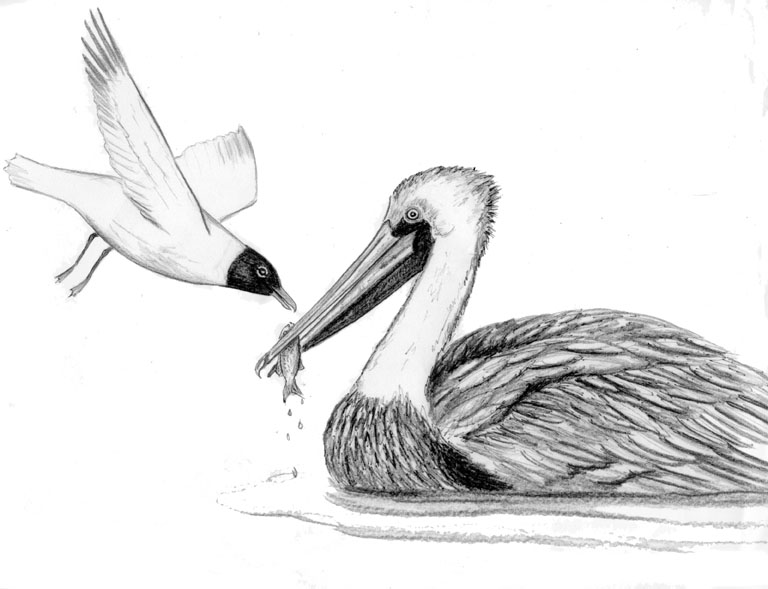
Dear Bird Folks,
I’ve just returned from a Florida vacation, where I spent most of my time being entertained by the pelicans. Is the pelican Florida’s state bird? If it isn’t, it should be.
– Joan, New Bedford, MA
No and no, Joan,
Florida has two species of pelicans. Brown Pelicans are common throughout the year, while the American White Pelican is only a winter visitor (just like the rest of us). Unfortunately for you pelican fans, neither one is Florida’s state bird. If you want to visit that state bird, you will have to take your next vacation in Louisiana, aka, the “Pelican State.” In 1958, the people of Louisiana officially designated the pelican as their state bird. However, it seems the officials neglected to announce which pelican they chose. Was it the white pelican or the Brown Pelican? Most Louisianians likely didn’t care, but the pelicans were totally confused. Neither species knew which one of them had won bragging rights. So, in 1966, officials cleared things up and officially-officially declared the Brown Pelican the winner. And like you, Joan, I think it was an excellent choice, and Florida’s loss.
The one thing that separates pelicans from other marine birds is their unique fishing style. Herons, Ospreys, kingfishers, etc. normally grab a single fish at a time, but pelicans are into quantity. They don’t want to go through all that work for just one fish. They use the dip net approach, like a clerk at Woolworth’s catching goldfish for customers. When a school of fish is spotted, the pelican will dive into the water, open its massive bill and scoop up as many fish as it possibly can. But unlike the dip nets used at Woolworth’s, the pelican’s bill also scoops up water, lots and lots of water. Nearly three gallons of water may also fit into the pelican’s enormous gular pouch. (FYI: Gular refers to the upper part of the throat and is pronounced “gyoo-luh,” but don’t worry about saying it correctly. No one ever uses the word, except for maybe scientists and pelicans.)
With an 84% success rate, pelicans are excellent at catching fish. Their favorite targets include herring, menhaden and pigfish. (Pigfish?) But catching the fish is the easy part. Ridding its pouch of all that water, while still holding on to the fish, is where it gets tricky. With its bill pushed tight against its chest, the pelican slowly forces the water out, while at the same time, trying to keep the fish in. Sometimes the pelican is totally successful and sometimes a few fish get away. But even when a fish is lucky enough to escape the gular pouch, its problems aren’t over. Often, a nearby gull sees the commotion and perches itself on top of the pelican’s head (really), where it waits to pounce on any escapees. It’s a funny sight to watch, unless you happen to be a herring or a pigfish. (Pigfish?)
Because they have short legs and webbed feet, pelicans are awkward on land, but they are strong swimmers and masters of flight. These large birds have the uncanny ability to effortlessly glide just above the water without ever flapping (or so it seems). In addition to their famous giant bills, Brown Pelicans also have a few other special adaptations. Air sacs just below their skin help cushion the impact of their sixty-foot-high dives into the ocean. Also, a pelican’s trachea and esophagus are located on the right side of its neck. In order to protect them from being damaged, a diving bird will rotate its body to the left at the moment of impact. It makes an awkward bird look even more awkward, but pelicans know what they are doing.
I don’t know how old you are, Joan, but if you voted for Teddy Roosevelt, you did the pelicans a favor. Like many creatures at the turn of the last century, birds were quickly being hunted into extinction. Finally, Teddy decided enough was enough, and declared that an island off the east coast of Florida should be off-limits to hunting. In 1903, Pelican Island became the first National Wildlife Refuge. Since then, 561 other wildlife refuges have been added to the system, preserving a huge assortment of nationwide habitats. With the new protection the pelican numbers rebounded, at least for a while; but by the 1950s, their numbers once again went into decline. Ironically, by the time Louisiana officially made the Brown Pelican its state bird, there were none left in the state. Sadly, the pelican had totally disappeared from the Pelican State. At first, officials blamed a string of hurricanes for damaging critical nest sites, but after further review they discovered the real culprit. Wanna take a guess what it was? I’ll bet you know. Oh, let’s just say it all together, “DDT.” It seems hard to imagine that it took so long for folks to realize how nasty DDT was, but back then we were also smoking cigarettes and driving Corvairs without using seat belts, so… Once DDT was banned, the birds quickly recoved and have been entertaining us ever since. Yay!
I’m glad you enjoyed watching the pelicans on your vacation, Joan. They are really fun, animated birds to watch. And in case you are wondering, Florida’s state bird is the Northern Mockingbird. Mockers are fine birds and are great singers, but their gular pouch is nothing special and they stink at catching pigfish. Based on that last fact alone, I think Louisiana made the better choice.